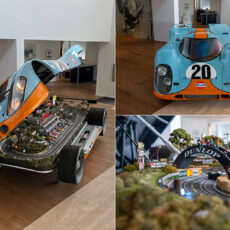
Back in 1967, the Turin Motor Show rolled out a vehicle that felt more like a spaceship than a car: the OSI Silver Fox, concocted by Italian coachbuilder Officine Stampaggi Industriali (OSI), a wild aerodynamic experiment that screamed ambition with its twin-boom look, adjustable wings, and a pint-sized engine that punched way above its class.
Founded in 1960 by ex-Ghia boss Luigi Segre, OSI had a flair for crafting oddball, small-batch rides for big names like Fiat, Ford, and Alfa Romeo. By the mid-1960s, though, the company was teetering on the edge of collapse. Facing financial ruin after Segre’s death in 1963, OSI poured its remaining energy into the Silver Fox, hoping it would be a showstopper to save the company. Designed by Sergio Sartorelli, the car was meant to compete in Group B6 racing and chase speed records, particularly at the grueling 24 Hours of Le Mans.
- Perfect Gift for Kids - This LEGO Technic Bugatti Bolide car toy model building set is an ideal gift for kids ages 9 and up, introducing them to...
- Explore Stunning Design - Discover the amazing design of the Bugatti Bolide with this LEGO Technic model race car building kit for motorsport fans and...
- Eye-Catching Display - With a yellow and black color theme and sticker detail, this LEGO Technic toy car model looks great on display in kids' rooms

Visually, the Silver Fox resembles a catamaran on wheels, with two narrow pods connected by a central cockpit and three aerodynamic wings. One pod housed the driver and a spare tire, while the other cradled a 1000cc Renault Alpine four-cylinder engine, tilted at an angle to optimize balance. This wasn’t a car built for raw power—its engine likely produced less than 100 horsepower. The Silver Fox skipped brute power, instead banking on a sleek, featherweight frame to hit a jaw-dropping 155 mph.

Its three spoilers—bridging the twin pods—were pure genius: a front wing you could tweak when stopped, a central one adjustable mid-drive, and a fixed rear wing that doubled as an air brake, all boosting downforce and stability to let it carve through the air like a rocket. Airflow zipped under the windshield and over the central wing, pinning the rear axle for extra grip, a slick move that later popped up in cars like the Fiat Barchetta.

Inside, the Silver Fox was as impractical as it was bold. The twin-pod layout left a wide, mostly unusable space between the driver and passenger, who sat cramped next to the engine. Steering was a puzzle, with a long rod running through the front airfoil to connect the driver’s wheel to the front tires. Only the driver’s-side front wheel steered, and both rear wheels were powered, giving it a quirky, almost motorcycle-like feel.


Sadly, the Silver Fox never got its shot at glory. OSI’s financial woes deepened, and by early 1968, the company folded, leaving the car as a one-off prototype. It ran a few test drives but never competed at Le Mans or set any records. Today, it survives in private hands, occasionally popping up at events like the Goodwood Festival of Speed, where it still baffles onlookers.
[Source]










